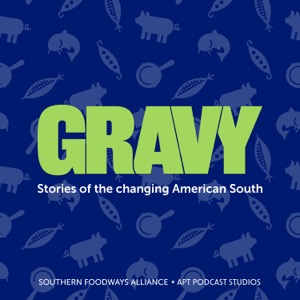Conch: Queen of the Florida Keys
Gravy - A podcast by Southern Foodways Alliance - Wednesdays

Categories:
In “Conch: Queen of the Florida Keys,” Gravy producer Adwoa Gyimah-Brempong takes listeners to the Keys, where queen conch is plastered across menus: conch fritters, conch salad, even conch chowder. The shells are a visual icon in Key West, even gracing its (semi-joking) flag as a sovereign nation: The Conch Republic. Which is fascinating… because conch hasn’t been fished on the island in fifty years. So where is it coming from, where is it going, and why is the culture so enduring? Conch is beloved both culturally and culinarily across the Caribbean, and the cuisine made its way to the Keys with an influx of Bahamians in the 1800s. It became a symbol of the slow way of life on the island, which chef Martin Liz points out is 40 miles closer to Cuba than it is to the nearest Walmart. It’s high in protein, easy to catch, versatile to prepare, and provides everything from building materials to precious pearls once harvested. But in the Florida Keys, conch was overfished to the point of near collapse in the 1970s and ‘80s. The reasons that it hasn’t rebounded are being studied by scientists in Florida and elsewhere, because their numbers are falling throughout the waters where it makes its home. Due to a combination of overfishing, warming waters, and changing ocean pH, it’s getting harder for conch to reach sexual maturity. And as density-dependent reproducers who grow and travel at a snail’s pace, once populations are depleted they are very slow to return. That’s a problem not just for kitchens, but for the ocean itself. As a bioengineer species that keeps seagrass beds vibrant and thriving, an ecosystem orbits around conch that spans from the tiniest algae all the way up to nurse sharks. It’s crucial for carbon sequestration, and also employs thousands of fishers around the Caribbean. Different countries have approached this in a variety of ways: many have closed seasons. The Bahamas has completely closed exports, while Jamaica recently inaugurated the first conch fishery with Marine Stewardship Council (MSC) certification. Florida Fish and Wildlife researchers are experimenting with transporting immature conch further offshore, where they can bulk up the gastropod dating pool. And Florida Atlantic University’s Queen Conch Lab, led by professor Megan Davis, is partnering with research institutions and fishers to protect conch for generations to come. In this episode, Gyimah-Brempong talks to Davis and her colleagues, as well as Gabriel Delgado, a researcher with Florida Fish and Wildlife, and Kristian Moree and Lachelle Russell, aquaculture technicians at Freeport mobile conch lab. She also interviews chefs who work with conch, including Martin Liz in Key West and Terry Eden Pratt in Grand Bahama. Michael Moxey, a Grand Bahama fisherman, tells of conch’s accessibility and an evolving way of life. United around a love and need for these large-eyed snails, island nations are both strengthening their economies and increasing their protection from ever-stronger hurricanes. Which, with any luck, will keep conch on the sea floor – and in the stew pot – for generations to come. Learn more about your ad choices. Visit megaphone.fm/adchoices
